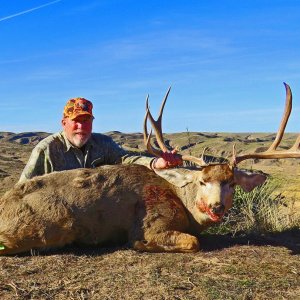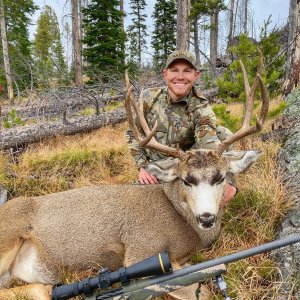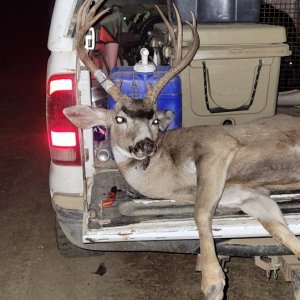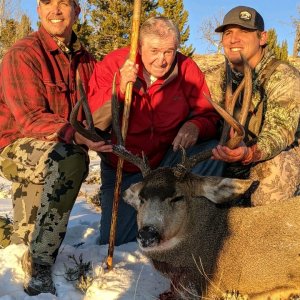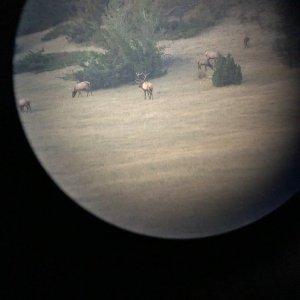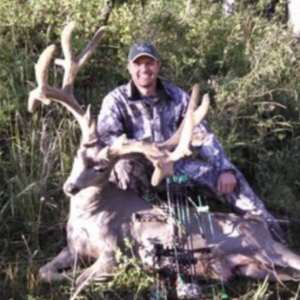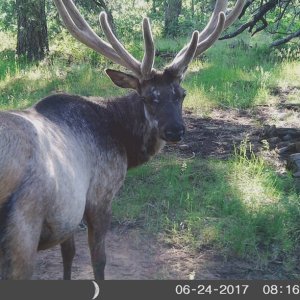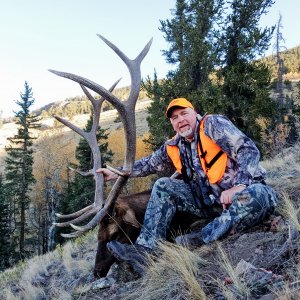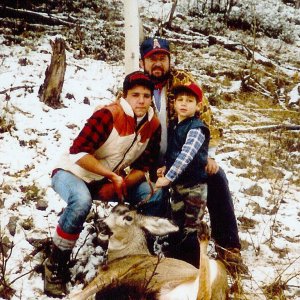You are using an out of date browser. It may not display this or other websites correctly.
You should upgrade or use an alternative browser.
You should upgrade or use an alternative browser.
Interesting note on deer movement.
- Thread starter feddoc
- Start date
feddoc
Long Time Member
- Messages
- 7,607
Many of us have probably witnessed bachelor groups of velvet bucks in high alpine and sagebrush prairie settings where they tend to have daily routines all summer long. They may spend a great deal of time feeding and watering in the same localized areas.
Once they shed their velvet, they seem to be an entirely different critter. They often head from the alpine into the timber or seem to vanish into thin air in open sagebrush country. From what I've seen in open sagebrush country, bucks (especially monster bucks) may be almost impossible to spook or move during daylight hours unless you practically step on them in October. Literally hundreds of hunters may drive or walk right by bucks bedded in sagebrush or holed up in timber. In country with lots of hunting pressure they are aware that if they move, their buddies are often shot!
My guess is that buck movements diminish (at least during daylight hours) once they shed their velvet. Many of us that have game cameras set up likely have noticed that bucks often turn nocturnal in October. Bucks may still move in October but my guess is that more of their movement takes place at night. If you have game cameras set up on waterholes you may notice they start watering more at night in late September/October than summer months when they are in velvet.
My guess is that once temperatures drop in the early fall and winter bucks tend to put the feedbags on and spend a lot more time browsing to prepare for winter. They may move around a little more but their movements (especially where there is hunting pressure) happens during the night.
It's fairly evident that buck movements likely increase once deep snow moves them to lower elevations and winter ranges. There also is obviously more movement during the rut. My guess is that buck movements are the highest in the entire year with deep snow and the rut.
My experience from game cameras set up during winter months (after hunting season) is that once bucks are on their winter ranges that movement once again diminishes unless deep snow or predators (lions in particular) move them to new areas. They often hole up and feed in areas with the highest nutrition of feed available to sustain them through the winter months.
My guess is that monster bucks are the most vulnerable to hunters prior to velvet being shed, winter snow movements, and rut timings. They are also more vulnerable when concentrated on winter ranges. Monster bucks are the least vulnerable to hunters from the time velvet is shed until deep snow and the rut.
If states truly want to limit harvest of mature bucks it is wise to ensure hunting seasons exist when bucks are the least vulnerable. Colorado's current rifle season dates and tag quotas are a prime example of poor management of a deteriorating mule deer herd.
Once they shed their velvet, they seem to be an entirely different critter. They often head from the alpine into the timber or seem to vanish into thin air in open sagebrush country. From what I've seen in open sagebrush country, bucks (especially monster bucks) may be almost impossible to spook or move during daylight hours unless you practically step on them in October. Literally hundreds of hunters may drive or walk right by bucks bedded in sagebrush or holed up in timber. In country with lots of hunting pressure they are aware that if they move, their buddies are often shot!
My guess is that buck movements diminish (at least during daylight hours) once they shed their velvet. Many of us that have game cameras set up likely have noticed that bucks often turn nocturnal in October. Bucks may still move in October but my guess is that more of their movement takes place at night. If you have game cameras set up on waterholes you may notice they start watering more at night in late September/October than summer months when they are in velvet.
My guess is that once temperatures drop in the early fall and winter bucks tend to put the feedbags on and spend a lot more time browsing to prepare for winter. They may move around a little more but their movements (especially where there is hunting pressure) happens during the night.
It's fairly evident that buck movements likely increase once deep snow moves them to lower elevations and winter ranges. There also is obviously more movement during the rut. My guess is that buck movements are the highest in the entire year with deep snow and the rut.
My experience from game cameras set up during winter months (after hunting season) is that once bucks are on their winter ranges that movement once again diminishes unless deep snow or predators (lions in particular) move them to new areas. They often hole up and feed in areas with the highest nutrition of feed available to sustain them through the winter months.
My guess is that monster bucks are the most vulnerable to hunters prior to velvet being shed, winter snow movements, and rut timings. They are also more vulnerable when concentrated on winter ranges. Monster bucks are the least vulnerable to hunters from the time velvet is shed until deep snow and the rut.
If states truly want to limit harvest of mature bucks it is wise to ensure hunting seasons exist when bucks are the least vulnerable. Colorado's current rifle season dates and tag quotas are a prime example of poor management of a deteriorating mule deer herd.
Last edited:
schoolhousegrizz
Very Active Member
- Messages
- 2,710
In my experience many of the bucks I have hunted don't move much at all. I'm talking zero to 300 yards
feddoc
Long Time Member
- Messages
- 7,607
.....
Literally hundreds of hunters may drive or walk right by bucks bedded in sagebrush or holed up in timber. In country with lots of hunting pressure they are aware that if they move, their buddies are often shot!
.......
My guess is that once temperatures drop in the early fall and winter bucks tend to put the feedbags on and spend a lot more time browsing to prepare for winter. They may move around a little more but their movements (especially where there is hunting pressure) happens during the night.
.......
[/B]
I kinda laughed at the first part I quoted from your post. I've hunted the same area in Colorado since 1968 when I get a tag. There is a North/South road with high canyon walls that doesn't get much pressure, except from passers by driving the road.
Every year I glass that wall and every year I spot a really good buck or two sitting in the brushy pine areas getting some facetime with the sun....and not moving. Usually not even an ear twitch. As I've gotten older, spotting those bucks is more of a game than a hunt for a shot. The really huge bucks can only be spotted from a hillside across the road, and then only if I get to a spot high on the hillside. They are still in the sun, but use the shorter pinion/brushy pine to hide themselves from the road drivers.
nfh
Long Time Member
- Messages
- 7,978
I can't prove it, but it's long been my theory that as soon as the rifle season opens blacktails have hidden caves that they retreat into until the season ends. They only come out at night to feed.
You hunting vampires or deer?
feddoc
Long Time Member
- Messages
- 7,607
CHUD like behavior.I can't prove it, but it's long been my theory that as soon as the rifle season opens blacktails have hidden caves that they retreat into until the season ends. They only come out at night to feed.
Bux n Dux
Active Member
- Messages
- 900
These are whitetail they are talking about. Muleys are a completely different animal. A lot of times a buck won’t move from an area if all their needs are met. Their movement patterns change during the different times of summer and fall. But many bucks will hold in an area until snow or does get them to move. Just because you can’t see them, doesn’t mean they aren’t there.
I learned a great deal a few years ago after drawing a limited Wyoming open sagebrush country muley tag. I scouted and archery hunted pretty hard. After seeing several awesome velvet bucks I was being super selective. I thought it would be fairly easy locating the same bucks in the same vicinity during rifle season since the country was so open.
I found out later during rifle season that this may have been a mistake. Pretty much every one of the bucks I saw on a regular basis in velvet seemed to totally vanish after they rubbed off their velvet. Many of them I never found again even on gamecams. Where the heck did they go in that open country?
My guess is some possibly migrated to private land and others just holed up in tiny out of the way areas where they knew they were safe and never moved! I nearly tripped over a couple of the bigger bucks during rifle season but it was an incredible amount of work finding them. Several I never saw again!
I found out later during rifle season that this may have been a mistake. Pretty much every one of the bucks I saw on a regular basis in velvet seemed to totally vanish after they rubbed off their velvet. Many of them I never found again even on gamecams. Where the heck did they go in that open country?
My guess is some possibly migrated to private land and others just holed up in tiny out of the way areas where they knew they were safe and never moved! I nearly tripped over a couple of the bigger bucks during rifle season but it was an incredible amount of work finding them. Several I never saw again!
Mature Blacktails are closely related to Vampires.You hunting vampires or deer?
lostinOregon
Very Active Member
- Messages
- 2,187
I did notice that it was a whitetail study. Interesting though. Blacktails are a very under rated deer to kill. Mature blacktails IMHO do become nocturnal after velvet is shed. Not just nocturnal but only moving at 10p to 4am and not at dusk/dawn. Mule deer seem to be a creature of their habitat. Some desert deer don’t migrate and still disappear after going hard horned. Seems like WY is learning a lot about their high country deer migrations. Incredible animals deer are.
My guess is that overall whitetail movements over a years time are a lot less than mule deer in Wyoming Colorado and other mountain states where whitetails generally are found in river bottoms.
I would also guess that whitetail bucks wander the most in those same states during the rut.
I would also guess that whitetail bucks wander the most in those same states during the rut.
There was an ODFW migration trail camera study in SW OR. Iirc one of their findings was mature BT moved almost exclusively at night. Vampires they are.I did notice that it was a whitetail study. Interesting though. Blacktails are a very under rated deer to kill. Mature blacktails IMHO do become nocturnal after velvet is shed. Not just nocturnal but only moving at 10p to 4am and not at dusk/dawn. Mule deer seem to be a creature of their habitat. Some desert deer don’t migrate and still disappear after going hard horned. Seems like WY is learning a lot about their high country deer migrations. Incredible animals deer are.
ICMDEER
Long Time Member
- Messages
- 3,015
I always say "follow the feed." Whitetails are kinda off my radar, but I know they are easy to pattern until the rut. Watch where they feed and they will be there right before sunset.
Mule deer are less predictable and are different in different areas. I just got back from Kansas. Those bucks are in milo and corn right now. Far different than the Grey's River bucks we chase here in Wyoming.
I've noticed the deer in our sagebrush/mahogany country here in Wyoming are often up higher on ridges until the feed there dries out (and the higher waters also dry up). They'll eat forbs mostly until the green is gone. Then they move to the good summer brush, which is generally mahogany. Then in the fall after the mahogany leaves fall off, they transition to bitterbrush if they can. Then after it gets cold and winter sets in, they are on sagebrush. All those moves might be within a couple of miles or they could be 10-30 miles. Depends upon the area.
If alfalfa is available, our mule deer will travel miles to get to it. Especially in the fall in the plains where the range feeds are dried up. That means they'll often bed 3-4 miles away from the alfalfa and travel almost nocturnally to it. Then feed all night and head back before daylight. I see that routinely.
Deer are all different in different areas. But in general, they want to eat well, drink regularly, and avoid chaos and predators, including humans. They'll be in the places you expect them, but they'll also be in places you'd never expect them. That's what makes them fun to hunt and learn about.
Mule deer are less predictable and are different in different areas. I just got back from Kansas. Those bucks are in milo and corn right now. Far different than the Grey's River bucks we chase here in Wyoming.
I've noticed the deer in our sagebrush/mahogany country here in Wyoming are often up higher on ridges until the feed there dries out (and the higher waters also dry up). They'll eat forbs mostly until the green is gone. Then they move to the good summer brush, which is generally mahogany. Then in the fall after the mahogany leaves fall off, they transition to bitterbrush if they can. Then after it gets cold and winter sets in, they are on sagebrush. All those moves might be within a couple of miles or they could be 10-30 miles. Depends upon the area.
If alfalfa is available, our mule deer will travel miles to get to it. Especially in the fall in the plains where the range feeds are dried up. That means they'll often bed 3-4 miles away from the alfalfa and travel almost nocturnally to it. Then feed all night and head back before daylight. I see that routinely.
Deer are all different in different areas. But in general, they want to eat well, drink regularly, and avoid chaos and predators, including humans. They'll be in the places you expect them, but they'll also be in places you'd never expect them. That's what makes them fun to hunt and learn about.

